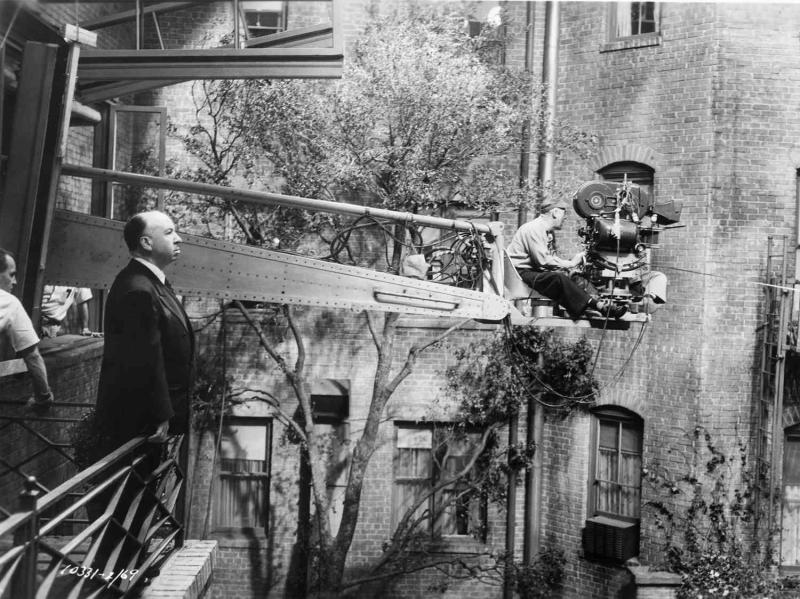Auteur Theory: Definition and Famous Auteur Directors
By: Christopher McKittrick (LiveAbout)



Auteur Theory: Definition and Famous Auteur Directors
Definition of the auteur theory in film, including a list of famous auteurs like Alfred Hitchcock, Charlie Chaplin, Orson Welles, Martin Scorsese
:max_bytes(150000):strip_icc():format(webp)/GettyImages-526903546-c5f7308f4e9844b888da510657de03b0.jpg)
1954-Director Alfred Hitchcock observes the action from a balcony as cameramen extended out on an 'arm' film a scene on the set of 'Rear Window' 1954. Corbis / Getty Images)
In film, the auteur theory is a theoretical concept that applies to a filmmaker (most typically a director) that creates a film from his or her singular version with significant or total creative control over the project. While film is a collaborative medium by nature, there are many examples of filmmakers who exhibit significant authorship over their projects, a practice that establishes them as "authors" (auteurs) of those films. Films made by auteur filmmakers often have a recognizable style, which may be visual, thematic, or another stylistic attribute.
The auteur theory was initially theorized by French film critics, including Andre Bazin, and was later popularized by American critic Andrew Sarris, who wrote about the concept in an influential 1962 essay titled "Notes on the Auteur Theory."
Did You Know?
In his 1968 book The American Cinema , critic Andrew Sarris ranked Buster Keaton, Orson Welles, Charles Chapin, and Alfred Hitchcock among the greatest film directors of all time.
Early Film Auteurs
Before the term was coined, there were many examples of filmmakers who played dominant creative roles on their projects, serving multiple roles as directors, writers, producers, and even actors. In the silent era, this included comedians Charles Chaplin ( The Kid , The Gold Rush , Modern Times ) and Buster Keaton ( Go West , The General ) and dramatic filmmakers like D.W. Griffith ( The Birth of a Nation , Intolerance , Broken Blossoms ). Even some popular movie stars had established enough industry clout to take multiple creative roles on their films, such as Douglas Fairbanks on his films Arizona (1918), The Mark of Zorro (1920), Robin Hood (1922), and The Thief of Bagdad (1924).
:max_bytes(150000):strip_icc():format(webp)/GettyImages-517324716-f432a32ae7b14c68b903a1e29a1cdb31.jpg)
The Gold Rush (1925) was written and directed by Charles Chaplin.
With the growth of the studio system and the major studios' focus on assembly-style production of films, it became less common for a single individual to work in multiple creative roles on a film. In some cases in that era, filmmakers who achieved significant artistic or box office success were able to take more control on their projects. Perhaps the best-known example of that during the studio era was Alfred Hitchcock, who by the end of the 1940s was both directing and producing his films at American studios.
Hitchcock was an exception—few other directors had that type of artistic control in Hollywood. Another example was Orson Welles, who came to Hollywood with a pedigree of success on the New York stage and on radio. Welles was given almost total control over the production of his debut film, Citizen Kane (1941), which he co-wrote, directed, produced, and starred in. Sarris himself wrote an essay declaring the great status of the film in 1956, and the American Film Institute declared Citizen Kane the greatest American film of all time in 1998. Unfortunately, for several reasons—including that Citizen Kane was not a commercial success at the U.S. box office—Welles never enjoyed the same measure of control over a film in his lifetime.
:max_bytes(150000):strip_icc():format(webp)/GettyImages-607384974-f124fda0bb6540a3a36faaab218a9762.jpg)
AKIRA KUROSAWA (Photo by Sunset Boulevard/Corbis via Getty Images).
International Cinema Auteurs
While the structure of Hollywood studios of the 1950s and 1960s did not typically allow for many auteurs, filmmakers were able to achieve artistic control over their projects in other countries. These auteurs included:
- France's Francois Truffaut ( The 400 Blows )
- France's Jean-Luc Godard ( Breathless )
- Sweden's Ingmar Bergman ( The Seventh Seal , Wild Strawberries )
- Italy's Federico Fellini ( La Dolce Vita , 8 1/2 )
- Japan's Akira Kurosawa ( Rashomon , Seven Samurai )
Several of these directors would win the Academy Award for Best Foreign Language Film, which became an annual award in 1957, bringing more attention to the auteur-style of filmmaking.
:max_bytes(150000):strip_icc():format(webp)/GettyImages-180258835-cb8e468c9d1b4dc393beff4e1bf50b61.jpg)
Director Martin Scorsese (left) as the 'Silhouette Watching Passenger', and Robert De Niro as Travis Bickle in 'Taxi Driver', directed by Scorsese, 1976.Silver Screen Collection / Getty Images
New Hollywood
In the late 1960s and throughout the 1970s, Hollywood and independent studios offered many filmmakers—including many who were influenced by international auteurs—the opportunity to create films with more artistic control. These auteurs included:
- Woody Allen ( Annie Hall , Manhattan )
- Robert Altman ( MASH , Nashville )
- Francis Ford Coppola ( The Godfather , The Conversation )
- Stanley Kubrick ( Dr. Strangelove , 2001: A Space Odyssey )
- Terrence Malick ( Badlands, Days of Heaven )
- Martin Scorsese ( Taxi Driver , Raging Bull )
Because of this radical shift from a heavy-handed approach from the studios, this era was dubbed "New Hollywood." In fact, some filmmakers like Steven Spielberg ( Jaws , Close Encounters of the Third Kind ) and George Lucas ( American Graffiti , Star Wars ) were able to make big-budget studio projects while maintaining creative control over them. However, by the early 1980s the major studios retreated from offering that much control to all but a handful of directors.
:max_bytes(150000):strip_icc():format(webp)/GettyImages-140302335-7e405d878cb3481ca2f9969bec4256f5.jpg)
NEW YORK, NY - MARCH 01: Actor Oscar Isaac, Director Joel Coen and Director Ethan Coen filming on location for 'Inside Llewyn Davis' on March 1, 2012 in New York City.Bobby Bank / WireImage
Modern Auteurs
While some "New Hollywood" directors like Allen, Scorsese, and Spielberg continued to work as auteurs throughout the 1980s and 1990s, a new crop of auteur filmmakers were able to establish their style with the rise of independent distributors like Miramax and Gramercy Pictures and studios' "speciality" labels like Fox Searchlight Pictures and Sony Pictures Classics, which released lower-budget films to arthouse theaters. These filmmakers include:
- Paul Thomas Anderson ( Magnolia , There Will Be Blood )
- Wes Anderson ( The Royal Tenenbaums , The Grand Budapest Hotel )
- Tim Burton ( Edward Scissorhands , Alice in Wonderland )
- Joel & Ethan Coen ( Fargo , No Country for Old Men )
- Steve McQueen ( Shame , 12 Years a Slave )
- Lynne Ramsay ( We Need to Talk About Kevin , You Were Never Really Here )
- Quentin Tarantino ( Pulp Fiction , Kill Bill )
Some of these filmmakers, like Burton and Tarantino, have been successful enough to work on projects with significant budgets and studio support, yet still maintain their own filmmaking styles.
With the current rise of digital film production and an increasing number of content platforms, it has become more common for filmmakers to create their own low-budget projects under their own artistic control.
Save that two members besides the Group Administrator have blanket approval to post and promote seeds and articles, all members of this group are welcome to post to the Group seeds, articles and comments provided that: 1) Promotion to the Front (Home) Page of seeds and articles must first be approved by the Group Administrator, and 2) Discussion of politics and/or religion will be limited to the plots and themes of the movies or TV movies and series themselves and any religious comments or proselytizing or commentary concerning current political circumstances not in reference to the movies or TV movies and series themselves will be deleted along with all CoC and ToS violations. As well, anything posted that the administer of this group deems to be offensive or off topic will be deleted. Videos and images that the administrator cannot open must be described in text or they will be deleted.





This article is about 8 years old, so there probably are more recent films directed by newer auteur directors since back then.
Alfred Hitchcock was well known for doing short cameos in his films. Here is an article that shows images and descriptions of them.
Every one of Alfred Hitchcock's cameos in his own films
LINK -> Every one of Alfred Hitchcock's cameos in his own films | Yardbarker
Can an article echo?